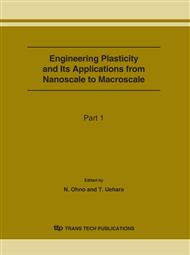p.587
p.593
p.599
p.605
p.611
p.619
p.627
p.633
p.639
Computer Aided Simulation of the Rheology Forging Process for Aluminum Alloys and its Experimental Investigation
Abstract:
Rheology forming is a novel processing method of semi-solid processing, which is different from traditional mold forging and conventional casting process. The rheological behavior of metallic alloys containing both solid and liquid phases was investigated with the low and high solid fraction ranges. Its obvious advantages are easier to produce complex work pieces because of excellent forming ability, more flexible to shape, and more compact in the inner quality for its high pressure. This research paper presents the theory of the rheology forming process and the results of the finite element simulation of rheology forming for aluminum alloys. In this proposed theoretical models for the rheology forming process involve simultaneous calculations performed with solid phase deformation and the liquid phase flow analysis. To analyze the rheology process, the new flow stress curves of rheology aluminum alloys and the viscosity for the simulation of two-phase flow phenomena have been proposed with as a function of temperature.
Info:
Periodical:
Pages:
611-618
Citation:
Online since:
June 2007
Price:
Сopyright:
© 2007 Trans Tech Publications Ltd. All Rights Reserved
Share:
Citation:


